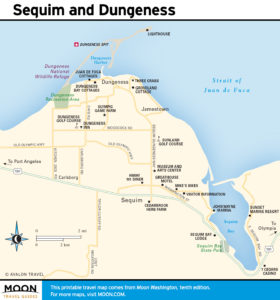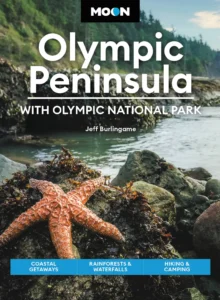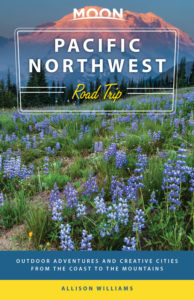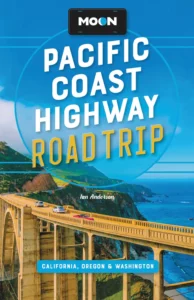Sequim and Dungeness
Forty minutes southwest of Port Townsend via Hwy-20 and US-101, Sequim (pop. 7,481; pronounced “SKWIM”) sits in the rain shadow of the Olympic Mountains and so tends to be much drier and sunnier than spots even a few miles west. Although it retains its rural feel, Sequim’s historic farming-and-fishing economy is quickly switching over to tourism. Tracts of homes are filling up the rolling waterfront landscape and a freeway bypasses the center of town. It’s still ideal cycling country, for the moment at least, with acres and acres of lavender farms lining quiet country roads.
Coming in from the east on two-lane US-101, the first thing you pass is the large, modern John Wayne Marina, built on land donated by The Duke’s family. The US-101 frontage through town is lined by the usual franchised fast-food outlets and some unique variations, like the 1950s-themed HIWAY 101 Diner (392 W. Washington St., 360/683-3388), in the heart of town.
Just north of US-101, the Sequim Museum & Arts Center (544 N. Sequim Ave., 360/681-2257, 11am-3pm Tues.-Sat., donation) houses everything from 12,000-year-old mastodon bones discovered on a nearby farm to exhibits of Native American cultures and pioneer farm implements. From the museum, a well-marked road winds north for 7 mi (4.3 km) before reaching the waterfront again at Dungeness Spit, where a 5.5-mi (3.4-km) sand spit, the country’s longest, protects a shellfish-rich wildlife refuge.
Cyclists and kayakers in particular like to stay near Sequim at the waterfront Juan de Fuca Cottages (182 Marine Dr., 360/683-4433, $129 and up), across from Dungeness Bay on a peaceful road about 7 mi (4.3 km) northwest of town.
Sequim and Dungeness Travel Map

















